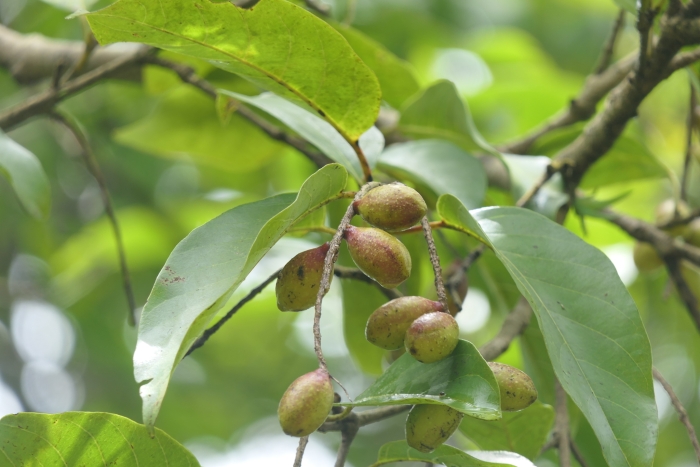Black Myrobalan
(Terminalia chebula)
Black Myrobalan (Terminalia chebula)
/
/

© Dinesh Valke
CC BY-SA 4.0
Image By:
© Dinesh Valke
Recorded By:
Copyright:
CC BY-SA 4.0
Copyright Notice:
Photo by: © Dinesh Valke | License Type: CC BY-SA 4.0 | License URL: http://creativecommons.org/licenses/by-sa/4.0/ | Uploader: dineshvalke | Publisher: iNaturalist |

























Estimated Native Range
Summary
Terminalia chebula, commonly known as black myrobalan, is a medium to large deciduous tree native to the forests and woodlands of South Asia and Southeast Asia, including India, Nepal, Bhutan, Sri Lanka, and parts of China. It can grow up to 98 feet tall with a trunk diameter of 1-2.5 meters. The tree’s canopy is broad and rounded, with oval leaves that are yellowish and pubescent beneath. It produces small, dull white to yellowish flowers with an offensive smell during the spring season, followed by ellipsoid or ovoid drupes that turn black when ripe. These fruits are a key source of traditional medicine and are particularly noted in Ayurvedic formulations like Triphala.
Black myrobalan is valued for its medicinal properties, as the fruit contains chebulic acid and other phenolic compounds known for their antibacterial activity. In cultivation, it is used for its health benefits and sometimes as a shade tree. It is also utilized in tanning and dyeing due to the high tannin content of the fruit. This tree prefers full sun to part shade, thrives in well-drained soil, and is tolerant of a variety of soil types, making it relatively easy to maintain. While it is not commonly seen in Western gardens, it is increasingly appreciated for its potential health benefits and as an exotic ornamental.
Potential problems include susceptibility to pests like caterpillars and borers, and it may require regular pruning to maintain a healthy structure. There is no significant risk of invasiveness when grown outside its native range, but as with any non-native species, care should be taken to monitor its growth and spread.CC BY-SA 4.0
Black myrobalan is valued for its medicinal properties, as the fruit contains chebulic acid and other phenolic compounds known for their antibacterial activity. In cultivation, it is used for its health benefits and sometimes as a shade tree. It is also utilized in tanning and dyeing due to the high tannin content of the fruit. This tree prefers full sun to part shade, thrives in well-drained soil, and is tolerant of a variety of soil types, making it relatively easy to maintain. While it is not commonly seen in Western gardens, it is increasingly appreciated for its potential health benefits and as an exotic ornamental.
Potential problems include susceptibility to pests like caterpillars and borers, and it may require regular pruning to maintain a healthy structure. There is no significant risk of invasiveness when grown outside its native range, but as with any non-native species, care should be taken to monitor its growth and spread.CC BY-SA 4.0
Plant Description
- Plant Type: Tree
- Height: 50-80 feet
- Width: 30-50 feet
- Growth Rate: Slow, Moderate
- Flower Color: White, Yellow
- Flowering Season: Spring, Summer
- Leaf Retention: Deciduous
Growth Requirements
- Sun: Full Sun
- Water: Medium
- Drainage: Medium, Fast
Common Uses
Bee Garden, Edible*Disclaimer: Easyscape's listed plant edibility is for informational use. Always verify the safety and proper identification of any plant before consumption., Low Maintenance
Natural Habitat
Forests and woodlands of South Asia and Southeast Asia
Other Names
Common Names: Hardh, Chebulic Myrobalan, Haritaki, Haritali, Harra, Myrobalan, Ink nut
Scientific Names: , Terminalia chebula, Buceras chebula, Combretum argyrophyllum, Myrobalanifera fertilis, Myrobalanus chebula, Myrobalanus gangetica, Myrobalanus tomentella, Terminalia acuta, Terminalia argyrophylla
GBIF Accepted Name: